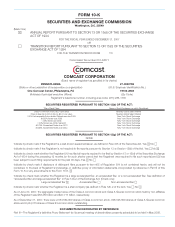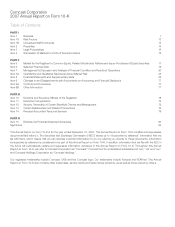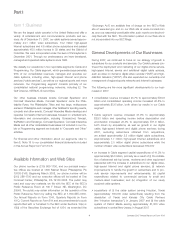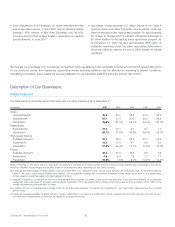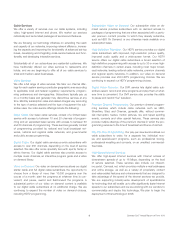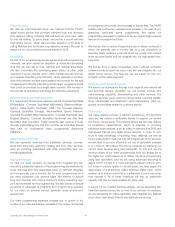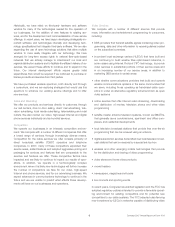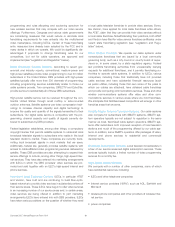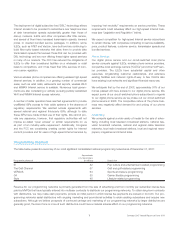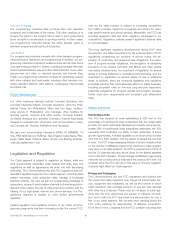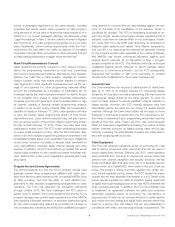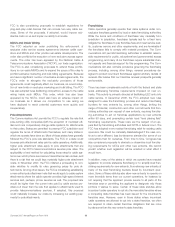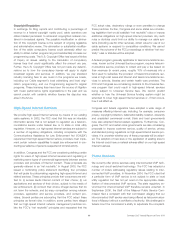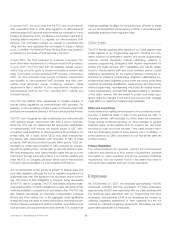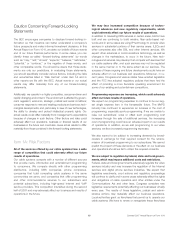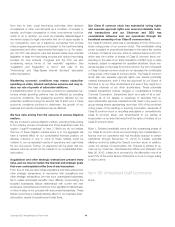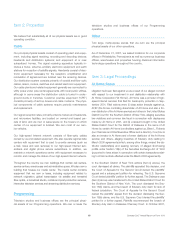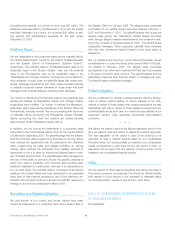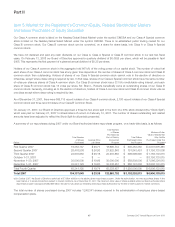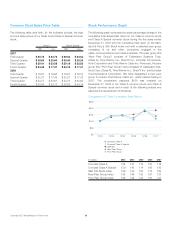Comcast 2007 Annual Report Download - page 10
Download and view the complete annual report
Please find page 10 of the 2007 Comcast annual report below. You can navigate through the pages in the report by either clicking on the pages listed below, or by using the keyword search tool below to find specific information within the annual report.
Sources of Supply
Our programming networks often produce their own television
programs and broadcasts of live events. This often requires us to
acquire the rights to the content that is used in such productions
(such as rights to screenplays or sporting events). In other cases,
our programming networks license the cable telecast rights to
television programs produced by third parties.
Competition
Our programming networks compete with other television program-
ming services for distribution and programming. In addition, our pro-
gramming networks compete for audience share with all other forms
of programming provided to viewers, including broadcast networks;
local broadcast stations; pay and other cable networks; home video,
pay-per-view and video on demand services; and Internet sites.
Finally, our programming networks compete for advertising revenue
with other national and local media, including other television net-
works, television stations, radio stations, newspapers, Internet sites
and direct mail.
Other Businesses
Our other business interests include Comcast Spectacor and
Comcast Interactive Media. Comcast Spectacor owns the Phila-
delphia Flyers, the Philadelphia 76ers and two large, multipur-
pose arenas in Philadelphia, and manages other facilities for
sporting events, concerts and other events. Comcast Interact-
ive Media develops and operates Comcast’s Internet businesses
focused on entertainment, information and communication, includ-
ing Comcast.net, Fancast, thePlatform and Fandango.
We also own noncontrolling interests in MGM, iN DEMAND, TV
One, PBS KIDS Sprout, FEARnet, New England Cable News, Pitts-
burgh Cable News Channel, Music Choice and Sterling Entertain-
ment (SportsNet New York).
Legislation and Regulation
Our Cable segment is subject to regulation by federal, state and
local governmental authorities under federal and state laws and
regulations as well as agreements we enter into with franchising
authorities. The Communications Act and FCC regulations and poli-
cies affect significant aspects of our Cable segment, including cable
system ownership, video subscriber rates, carriage of broadcast
television stations, the way we sell our programming packages to
subscribers, access to cable system channels by franchising author-
ities and other parties, the use of utility poles and conduits, and the
offering of our high-speed Internet and phone services. Our Pro-
gramming segment is subject to more limited governmental
regulation.
Federal regulation and regulatory scrutiny of our Cable and Pro-
gramming segments has been increasing under the current FCC,
even as the cable industry is subject to increasing competition
from DBS providers, telephone companies and others for video,
high-speed Internet and phone services. Meanwhile, the FCC has
provided regulatory relief and other regulatory advantages to our
competitors. Regulatory policies present significant adverse risks
to our businesses.
The most significant regulatory developments during 2007 were
the adoption of a cable ownership limit, the implementation of FCC
regulations constraining our provision of set-top boxes, the ex-
pansion of must-carry and leased access obligations, the exten-
sion of program access obligations, the abrogation of exclusivity
provisions in our access contracts with MDUs and other private
real estate developments, the enactment of legislation by several
states to provide statewide or simplified local franchising, and the
enactment or application by several states of new or additional
taxes. In addition, there are numerous legislative and regulatory
proposals pending that could adversely affect our Cable business,
including proposed rules on two-way plug-and-play equipment,
expanded obligations for program access and program carriage,
further must-carry requirements and increased pole attachment
rates.
Video Services
Ownership Limits
The FCC has adopted an order establishing a 30% limit on the
percentage of multichannel video subscribers that any single cable
provider can serve nationwide. Because we currently serve approx-
imately 26% of multichannel video subscribers nationwide, the 30%
ownership limit constrains our ability to take advantage of future
growth opportunities. A federal appellate court struck down a similar
30% limit in a 2001 decision, and we expect to appeal the new limit
in court. The FCC is also assessing whether it should reinstate a limit
on the number of affiliated programming networks a cable operator
may carry on its cable systems. The FCC’s previous limit of 40% of
the first 75 channels was also struck down by the federal appellate
court in the 2001 decision. The percentage of affiliated programming
networks we currently carry is well below the previous 40% limit. It is
uncertain when the FCC will rule on this issue or how any regulation
it adopts might affect our Cable segment.
Pricing and Packaging
The Communications Act and FCC regulations and policies limit
the prices that cable operators may charge for limited basic ser-
vice, equipment and installation, as well as the manner in which
cable operators may package premium or pay-per-view services
with other tiers of service. These rules do not apply to cable sys-
tems that the FCC determines are subject to effective competi-
tion, but to date the FCC has made this determination for only a
few of our cable systems. We currently have pending before the
FCC many petitions for determination of effective competition.
From time to time, Congress and the FCC consider imposing new
Comcast 2007 Annual Report on Form 10-K 8

